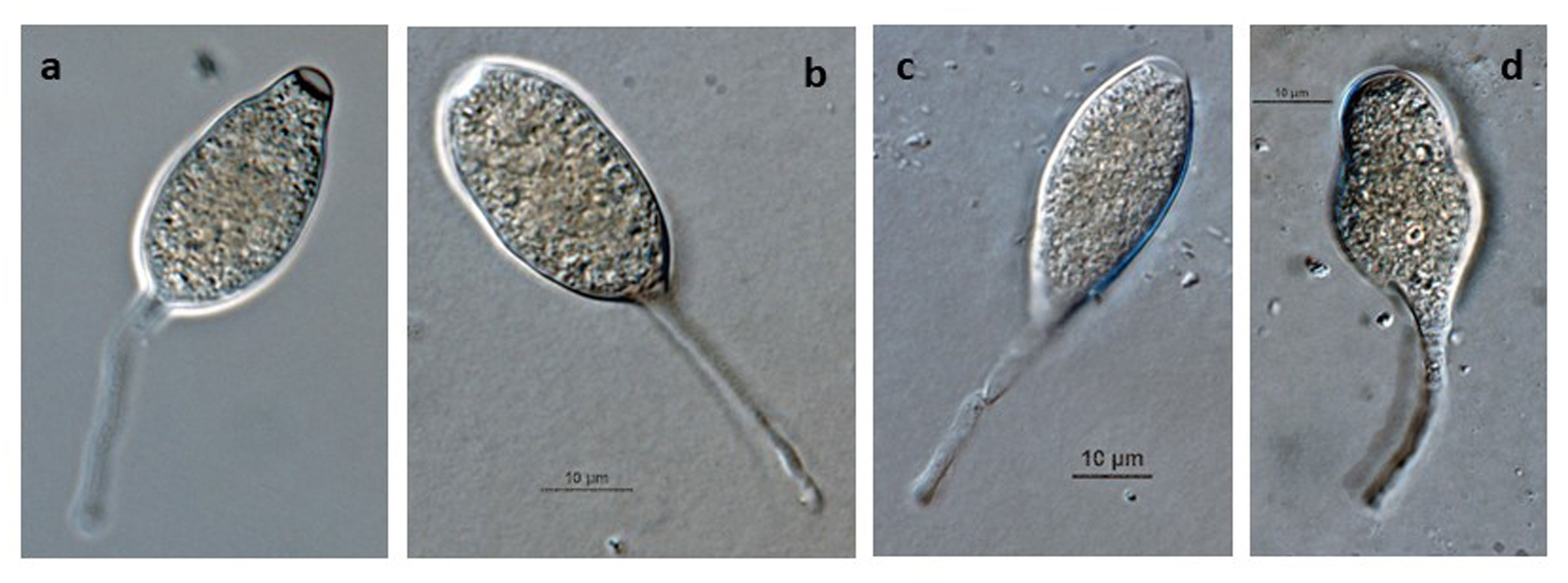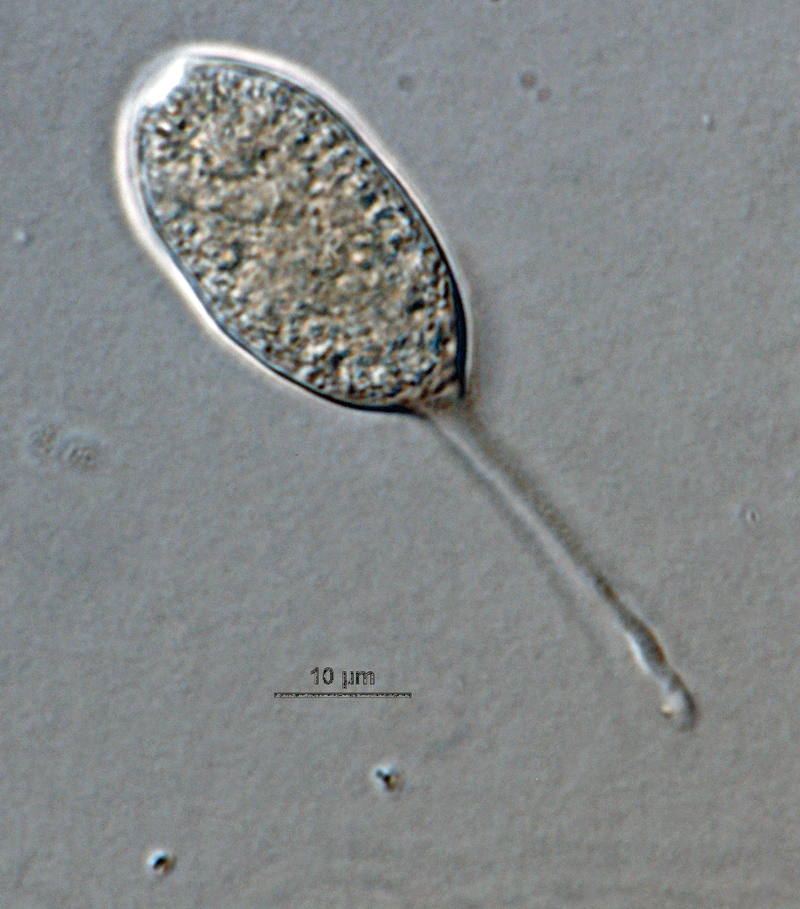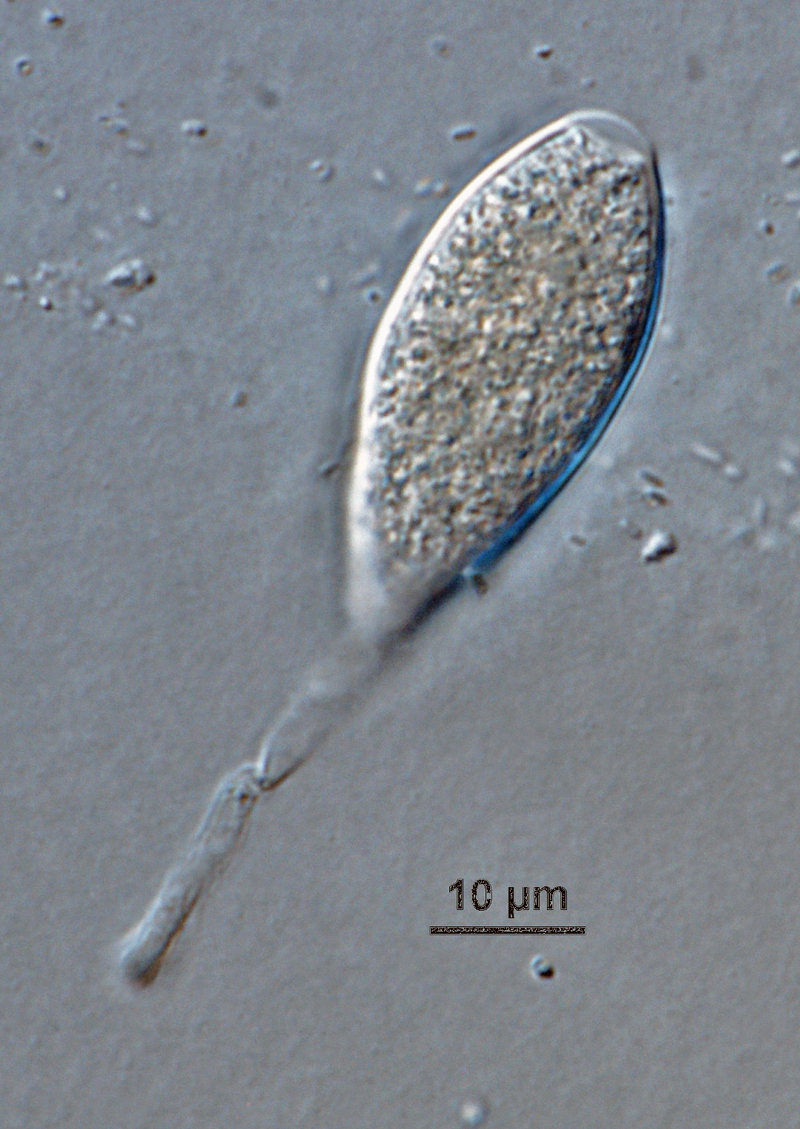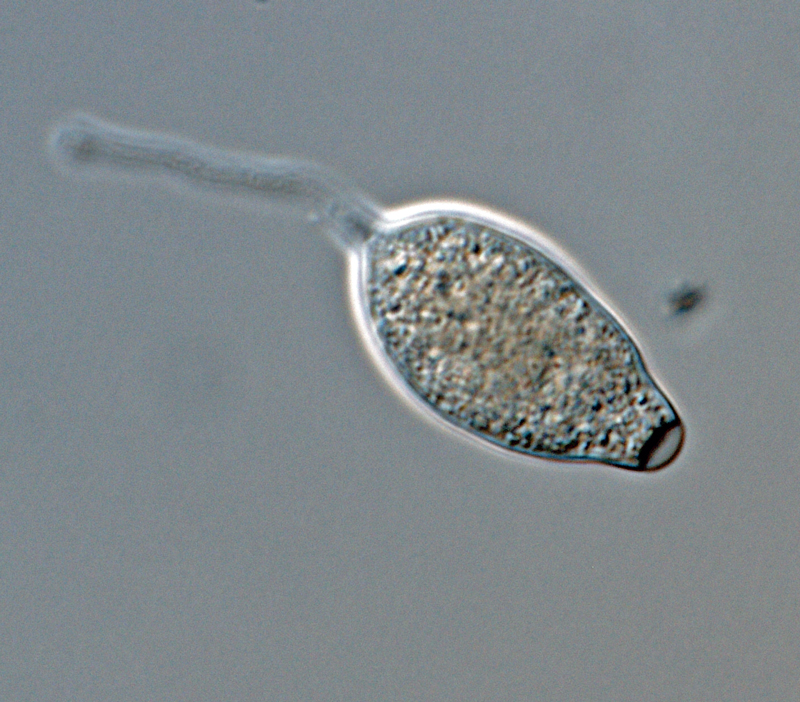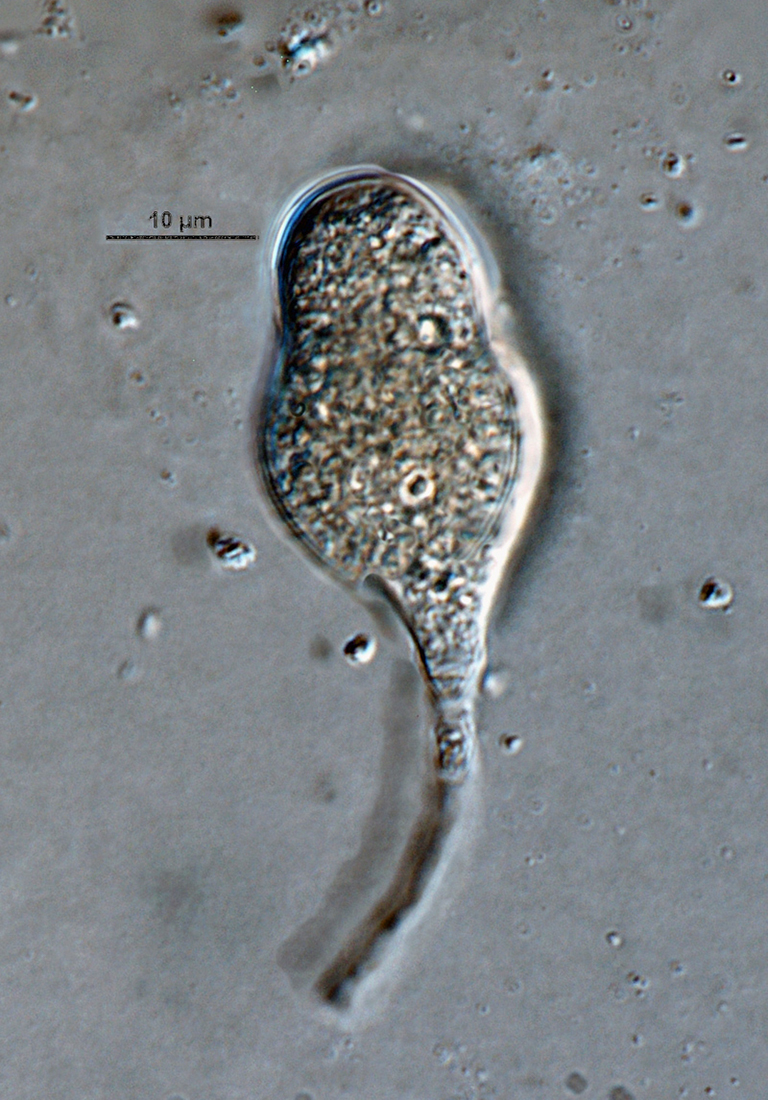Phytophthora hibernalis (in progress - Abad et al. 2023b)
|
Phytophthora spp. in subclade 8c: portion of the seven-loci ML phylogeny featuring the type cultures of 212 described species (by T. Bourret). Notice the position of P. hibernalis selected specimen CBS 114104 = S&T BL 41G. Gloria Abad, USDA S&T.
|
|
Phytophthora spp. in subclade 8c: Morphological Tabular key (PDF) and Tabular key legends (PDF) in IDphy2 KEY SECTION. Notice the data of P. hibernalis selected specimen CBS 114104 = S&T BL 41G. Gloria Abad, USDA S&T.
|
|
Phytophthora hibernalis (CPHST BL 41G) colonies of the ex-epitype grown for 7 days on (a) V8® Agar, (b) potato dextrose agar, and (c) malt extract agar; photo by Krysta Jennings and Leandra Knight, USDA-APHIS-PPQ |
|
Phytophthora hibernalis (CPHST BL 41G) sporangia in sporangiophore; photo by Gloria Abad, USDA-APHIS-PPQ |
|
Phytophthora hibernalis (CPHST BL 41G) asexual phase: (a–d) semipapillate sporangia, caducous with medium to long pedicels; photos by Gloria Abad, USDA-APHIS-PPQ. |
|
Phytophthora hibernalis (CPHST BL 41G) asexual phase: semipapillate caducous sporangium, with medium length pedicel; photo by Gloria Abad, USDA-APHIS-PPQ. |
|
Phytophthora hibernalis (CPHST BL 41G) asexual phase: semipapillate caducous sporangium, with medium length pedicel; photo by Gloria Abad, USDA-APHIS-PPQ. |
|
Phytophthora hibernalis (CPHST BL 41G) asexual phase: semipapillate caducous sporangium, with medium length pedicel; photo by Gloria Abad, USDA-APHIS-PPQ. |
|
Phytophthora hibernalis (CPHST BL 41G) asexual phase: semipapillate caducous sporangium, with medium length pedicel; photo by Gloria Abad, USDA-APHIS-PPQ. |
Name and publication
Phytophthora hibernalis Carne (1926)
Carne WM. 1926. A brown rot of citrus in Australia (Phytophthora hibernalis n. sp.). Journal of the Royal Society of Western Australia 12: 13–42.
Nomenclature
Mycobank
Typification
from Carne (1926)
Type: AUSTRALIA, on fruit, leaves, and smaller branches of Citrus spp. in Western Australia, South Australia, and probably Victoria, Queensland and Mediterranean Region (Carne 1925). The types of the new species are at present in the authors collections (page 43, Carne 1925).
Ex-type: LOST
Well-authenticated specimen selected by Gloria Abad:
CPHST BL 41G = P3822 (WPC) from citrus (Citrus sinensis) AUSTRALIA
Selected specimen in other collections
(SE) CBS 114104, NRRL 64317, WPC P3822, ATCC 56353, CABI IMI134760 (PA), S&T BL 41G (Abad), 32F7 (Hong), CMI13460
Molecular identification
Voucher sequences for barcoding genes (ITS rDNA and COI) of the selected specimen (see Molecular protocols page)
Phytophthora hibernalis isolate CPHST BL 41G (= P3822 WPC) = ITS rDNA MG865506, COI MH136900
Voucher sequences for Molecular Toolbox with seven genes (ITS, β-tub, COI, EF1α, HSP90, L10, and YPT1
(see Molecular protocols page) (In Progress)
Voucher sequences for Metabarcoding High-throughput Sequencing (HTS) Technologies [Molecular Operational Taxonomic Unit (MOTU)]
(see Molecular protocols page) (In Progress)
Sequences with multiple genes for selected specimen in other sources
- NCBI: Phytophthora hibernalis CPHST BL 41G
- NCBI: Phytophthora hibernalis P3822
- EPPO-Q-bank: Phytophthora hibernalis CBS 114104
- BOLDSYSTEMS: Phytophthora hibernalis PHYTO 176-10 = P3822 (barcoding COI & ITS)
Position in multigenic phylogeny with 7 genes (ITS, β-tub, COI, EF1α, HSP90, L10, and YPT1)
Clade clade:
a taxonomic group of organisms classified together on the basis of homologous features traced to a common ancestor
8c
Genome sequence
Phytophthora hibernalis strain ex-epitype BL41G. Accession genome USDA_Phib_BL41_1.0 reference, BioProject PRJNA605765, USDA-APHIS-PPQ-S&T (2020), Srivastava et al 2022
Morphological identification
Colonies and cardinal temperatures
Colony colony:
assemblage of hyphae which usually develops form a single source and grows in a coordinated way
morphology on V8-A, PDA, and MEA with no distinct pattern. Minimum growth temperature 6°C, optimum 15–21°C, and maximum 25°C.
Asexual phase
SporangiaSporangia:
sac within which zoospores form, especially when water is cooled to about 10°C below ambient temperature; in solid substrates, sporangia usually germinate by germ tubes
semipapillatesemipapillate:
pertaining to the production of shallow having papilla that are not well developed, shallow and less nipple-like than fully papillate structures
; caducouscaducous:
pertaining to sporangia that become dislodged readily (i.e. deciduous) and separate from the sporangiophore (cf. persistent)
with medium to long pedicels (18–74 µm long); elongate, ellipsoidellipsoid:
refers to a solid body that forms an ellipse in the longitudinal plane and a circle in cross section; many fungal spores are ellipsoidal or elliptic
, ovoidovoid:
egg-shaped, with the widest part at the base of the sporangium and the narrow part at the apex
, or obovoidobovoid:
inversely egg-shaped; ovoid, but with the widest part at the apex
(21–44 L x 13–22 W µm); produced in unbranched or in lax sympodial branching, or occasionally in umbellate sporangiophores. Hyphal swellings absent. Chlamydospores absent.
Sexual phase
Homothallic. OogoniaOogonia:
the female gametangium in which the oospore forms after fertilization by the antheridium
smooth-walled (24–36 µm diam); antheridiaantheridia:
the male gametangium; a multinucleate, swollen hyphal tip affixed firmly to the wall of the female gametangium (the oogonium)
predominantly amphigynousamphigynous:
pertaining to the sexual stage in which the antheridium completely surrounds the stalk of the oogonium (cf. paragynous)
, often intercalaryintercalary:
positioned within a hypha (cf. terminal)
, some with multiple radiating hyphaehyphae:
single, tubular filament of a fungal or oomycete thallus; the basic structural unit of a fungus or oomycete
or spines; oosporesoospores:
zygote or thick-walled spore that forms within the oogonium after fertilization by the antheridium; may be long-lived
pleroticplerotic:
pertaining to an oospore that fills the oogonium (cf. aplerotic)
(22–30 µm in diam).
Most typical characters
Phytophthora hibernalis is distinguished by the production of elongate, caducouscaducous:
pertaining to sporangia that become dislodged readily (i.e. deciduous) and separate from the sporangiophore (cf. persistent)
sporangia with medium to long pedicels.
Specimen(s) evaluated
Phytophthora hibernalis CPHST BL 41G, duplicate of P3822 (World Oomycetes/Phytophthora Collection)
Hosts and distribution
Distribution: Africa (South Africa); Asia (Israel); Australasia; Europe; North America (USA: CA); Central America; Caribbean; South America (Argentina, Brazil, Venezuela)
Substrate: fruits, leaves, twigs
Disease note: brown rot of fruit; leaf and twig blight
Hosts: multiple hosts, foliage/fruits, primarily Citrus spp. (Rutaceae); on 11 genera in 9 families
Retrieved January 31, 2018 from U.S. National Fungus Collections Nomenclature Database.
Additional references and links
- SMML USDA-ARS: Phytophthora hibernalis
- EPPO Global Database: Phytophthora hibernalis
- Forest Phytophthoras of the world: Phytophthora hibernalis
- CABI Digital Library: Phytophthora hibernalis
- Encyclopedia of Life (EOL): Phytophthora hibernalis
- Index Fungorum (IF): Phytophthora hibernalis
- Google All Phytophthora hibernalis
- Google Images Phytophthora hibernalis
- Google Scholar Phytophthora hibernalis
Fact sheet author
Z. Gloria Abad, Ph.D., USDA-APHIS-PPQ-S&T Plant Pathogen Confirmatory Diagnostics Laboratory (PPCDL), United States of America.



